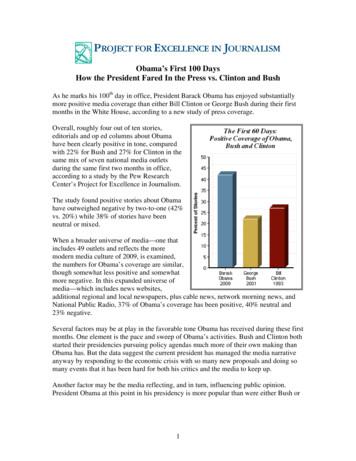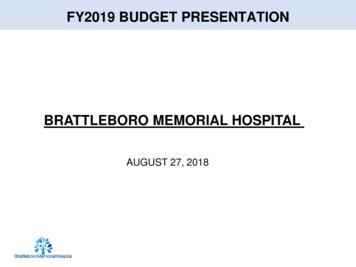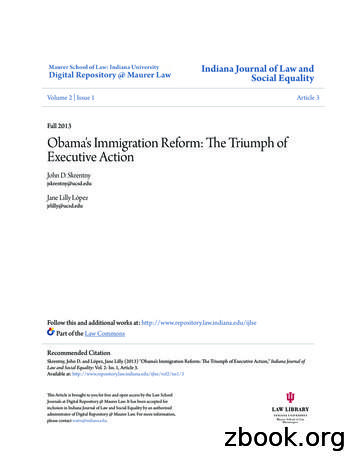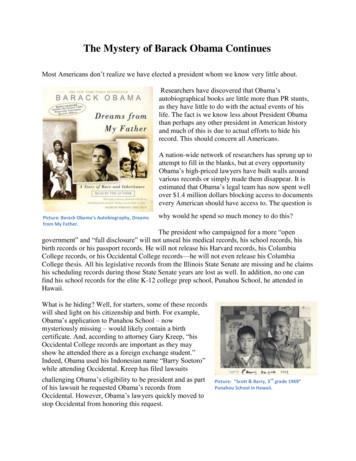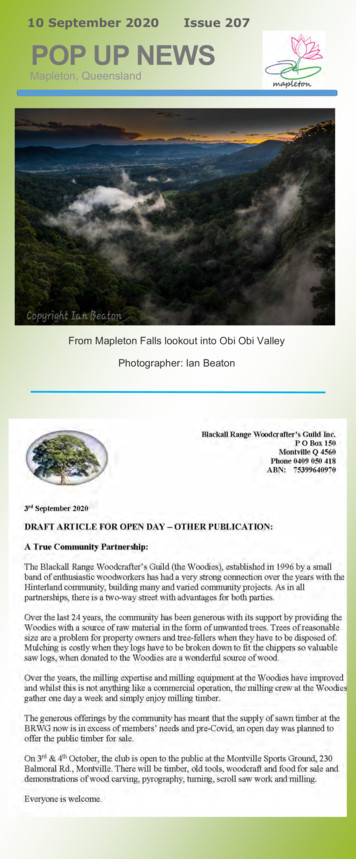Obama’s First 100 Days How The President Fared In The .
Obama’s First 100 DaysHow the President Fared In the Press vs. Clinton and BushAs he marks his 100th day in office, President Barack Obama has enjoyed substantiallymore positive media coverage than either Bill Clinton or George Bush during their firstmonths in the White House, according to a new study of press coverage.Overall, roughly four out of ten stories,editorials and op ed columns about Obamahave been clearly positive in tone, comparedwith 22% for Bush and 27% for Clinton in thesame mix of seven national media outletsduring the same first two months in office,according to a study by the Pew ResearchCenter’s Project for Excellence in Journalism.The study found positive stories about Obamahave outweighed negative by two-to-one (42%vs. 20%) while 38% of stories have beenneutral or mixed.When a broader universe of media—one thatincludes 49 outlets and reflects the moremodern media culture of 2009, is examined,the numbers for Obama’s coverage are similar,though somewhat less positive and somewhatmore negative. In this expanded universe ofmedia—which includes news websites,additional regional and local newspapers, plus cable news, network morning news, andNational Public Radio, 37% of Obama’s coverage has been positive, 40% neutral and23% negative.Several factors may be at play in the favorable tone Obama has received during these firstmonths. One element is the pace and sweep of Obama’s activities. Bush and Clinton bothstarted their presidencies pursuing policy agendas much more of their own making thanObama has. But the data suggest the current president has managed the media narrativeanyway by responding to the economic crisis with so many new proposals and doing somany events that it has been hard for both his critics and the media to keep up.Another factor may be the media reflecting, and in turn, influencing public opinion.President Obama at this point in his presidency is more popular than were either Bush or1
Clinton. Past studies have shown a recurring pattern of press coverage tending to followfavorability ratings. 1Obama also entered office with a stronger popular mandate than either of his twopredecessors. He is the first President since George H.W. Bush in 1988 to be elected tohis first term with more than 50% of the popular vote. He also succeeded a presidentleaving office with historically low favorability ratings.Finally, those who see the press as ideologically motivated toward liberals will likely seethat phenomenon as a factor here as well.Among other differences, the tone of Obama’s coverage has also proven to be moreconsistent over time than his predecessors’. Sixteen years ago, Bill Clinton stumbledbadly his first month in office and then began to recover; George Bush started well in thepress and then began to see his coverage become more skeptical as his policy agendarolled out, often to substantial controversy. Obama, by contrast, while he has had goodweeks and bad in the media, has shown a capacity to recover from the rough ones bychanging tactics and redirecting the narrative.These are a few of the findings of the new study, which compared coverage of the first 60days of the Obama Administration to coverage in the same outlets during the same timeperiod in the first days of the Bush Administration and the Clinton Administration. Thecomparative component of the study includes an examination of 1,261 stories in twonational newspapers, the three commercial network evening newscasts, a prominentnewsweekly and the NewsHour on PBS.1Pew Research Center for the People & the Press, “Obama at 100 Days: Strong Job Approval, Even HigherPersonal Ratings Better Ratings for Foreign Policy than Domestic Issues,” April 23, 2009. Obama’sapproval rating at roughly the 100 day mark was 63%, compared with 56% for George W. Bush and 55%for Bill Clinton.2
The new study also looked at an expanded universe of media outlets that more fullyreflects the new media culture. That larger universe also includes the three cable newschannels, the three commercial network morning news programs, National Public Radio,12 news websites, and 11 additional newspapers.Among the findings in the study: In contrast with Clinton and Bush, Obama’s treatment was more favorablethan skeptical both in news coverage and on newspaper opinion pages. ForClinton, on the other hand, news coverage tilted toward the negative, whilenewspaper op eds and editorial offered favor. The treatment went the otherway for Bush, with news coverage leaning positive, while op ed and editorialsstudied were decidedly negative. The topics covered have also has been different for Obama versus hispredecessors. Roughly twice as much of the coverage of Obama (44%) hasconcerned his personal and leadership qualities than was the case for Bush(22%) or Clinton (26%). Less of the coverage, meanwhile, has focused on hispolicy agenda. Thanks in part to Obama’s getting out of Washington and meeting directlywith the public, far more of the coverage has dealt with his relationship withthe American people (31% of all stories) than was the case with Clinton(16%) or Bush (8%). Much more of Bush’s coverage centered on his relationswith Congress and ways in which he wanted to change the reputation of theoffice of the president—largely institutional issues, while Clinton’s coveragescattered in many directions. This focus on the public has also been a factor in3
the positive tone of the coverage, both because it plays to one of Obama’spolitical strengths and because the citizen voices have often been so favorable. There are significant variations in how the different media sectors havecovered the Obama presidency. Newspapers and evening network televisionwere most positive in their treatment of Obama. Online news sites were moreneutral. Within the cable news universe, MSNBC and Fox News offeredstrikingly different portrayals of the young presidency, while CNN moreclosely reflected the tone of the media overall. Meanwhile, NPR and PBSoffered the highest percentage of neutral stories of any outlets studied.This study was designed to examine how the press assessed the new president, to breakdown the basis of those assessments and to compare this early period with both Clintonand Bush.To accomplish this, the study examined the following:1. How many stories were done?2. What was the basic topic of each story?3. What underlying area of the presidency was the story assessing—was it thepresident’s leadership abilities, his ideological agenda or his personal character?4. What was the tone of the coverage—neutral/balanced, demonstrably positive ordemonstrably negative?5. What narrative frame was the story built around—conflict, explaining policy,explaining tactics, a reality check, etc.?6. What political relationship did the story focus on—the president’s relationship tohis staff, to members of Congress, to the office, to interest groups, to citizens?Stories that were very short—under 30 seconds on television and under 100 words inprint, were excluded.Total Amount of CoverageGiven his popularity, some might imagine that Obama has generated media attention likefew presidents before him. It isn’t so.Actually, Clinton was the dominant figure in more stories than Obama in their first twomonths when the same media outlets are compared. 2 Overall, there were 566 Clintonstories, 333 for Bush and 362 for Obama.One major reason for the difference is that the space in newspapers even among thecountry’s biggest has gotten so much smaller. There were 324 stories about Clinton in thefirst two months of his presidency in the Washington Post and New York Times, 202about Bush and 176 about Obama.2For an individual to be considered the dominant newsmaker, 50% percent of the story must be about thatperson.4
Yet the shrinking print newshole does not completely explain the smaller number ofObama stories. Clinton was also the dominant subject more frequently than Obama instories on the three commercial network newscasts and the NewsHour with Jim Lehrer onPBS as well—193 Clinton stories, 111 for Bush and 156 stories for Obama. Our sense isthat the economy and its myriad problems are such a dominant story that the ObamaAdministration was often a part but not always the dominant subject of the reports.TONEThe most striking difference in Obama’s media narrative is the degree to which he hasenjoyed considerably more positive press than either of his predecessors at the beginningof their first terms.Overall, positive stories outnumberednegative ones by better than two-to-one(42% to 20%). Another 38% were neutralor mixed.For both President Bush and PresidentClinton, by contrast, the bulk of thecoverage was neutral, and negativecoverage slightly outweighed positive.For President Bush in 2001, for instance,just 22% of the stories carried a clearlypositive tone, nearly half that of Obama,while 28% were negative. Roughly half ofall Bush’s coverage was neutral.Eight years earlier, the tone of PresidentClinton’s coverage was just slightly morepositive. In the same outlets during thesame time period, 27% of stories were clearly favorable, while 28% were negative and44% were neutral.There were also differences in the context in which the three presidents earned favorablenotice. For Bush, his broad image as a skillful manager determinedly pursuing aconservative agenda scored him points on leadership but generated more negativecoverage when it came to his ideology.Clinton’s early coverage created the image of a president connected to people but throughoften highly calculated actions that were designed to win him popularity. The calculatedleadership style brought criticism while his policy assessments were more mixed.5
Obama, on the other hand, was praised on all fronts—policy, leadership and character.With the challenge of addressing both his own campaign agenda of change and thatwhich history brought upon him—the economy—coverage boiled down to the broadquestion of whether he was succeeding. Whether assessed by his policy choices,leadership and personality, the answer was largely, ‘yes’.The most positive coverage—though it represented the smallest share—was focused onObama’s character: his honesty, temperament and personality. Fully 72% of all storieshere were positive in nature. That is far better than Clinton (31%). Yet it is even betterthan Bush, whom the press in these early days assessed quite favorably on character(46% positive and 15% negative).Some of the praise came from the press itself, but much also came from the voices ofthose Obama interacted with on the road. In reporting on Obama’s trip to Fort Myers,Fla., on February 11, for instance, CBS World News correspondent Julie Cheninterviewed a man, Julio Asegueda, who had been at the event. “When I voiced myproblem to the president of the United States,” Asegueda said, “I was so shocked at theanswer that he gave me. The answer that he gave me was so, so sincere and somotivational to me that it just—I had such a surreal feeling that I've never had in mylife.”Obama also won the battle for coverage when it came to stories about his political agendaand ideology. These stories were nearly three times as positive as negative (46% versus16% negative).6
In many outlets the praise was simple and straightforward. In a February 27 World NewsTonight report, Charles Gibson summed up Obama’s announced timetable for troopwithdrawal from Iraq. “Obama took a giant step toward ending it. After six years of war,a most significant movement.”When it came to ideology and political agenda, Obama’s positive image again faroutweighed Clinton’s (whose core ideology coverage was 28% positive and 28%negative) and even more so Bush’s (for whom only 17% of stories were positive while36% were negative).Among the reasons for Bush’s problems when it came to ideology and agenda were hissometimes contradictory remarks, and questions, at times, about his grasp of details.A March 15, 2001 page one story at the Washington Post, for instance, read, "Bushappeared to send mixed signals about the U.S. economy. To reporters, he said he wasconcerned about the market turmoil but has ‘great faith in our economy.’ Later, in aspeech, he declared: “Our economy is beginning to sputter.” Soon after Bush becamemuch more guarded when the issue of the economy arose.Assessments of Clinton’s policies were more divided. He was largely praised for hispledge on welfare reform. A Washington Post story quoted Republican governorsTommy Thompson and John Engler, as “very excited,” Senator Moynihan as “hugelygratified,” and welfare analyst Robert Rector as calling it “a very dramatic departure fromDemocratic proposals in the past.”But he also received harsh criticism for other policies like in gays in the military.7
The most mixed assessments of Obama came in coverage that assessed his leadershipabilities and skills. Some of the criticism came over a lack of clarity in explaining himselfto the people. Warren Buffet in a March 10 segment by Chuck Todd on the Today Showremarked, “You need the president of the United States to make it clear, because ifpeople aren’t clear they are going to be confused and if they’re confused they’re going tobe scared stiff.”But others like Newsweek’s Jonathan Alter praised his leadership skills. In explaining hisconfidence in the President, Alter wrote that Obama has “a firm grasp of thepsychological and substantive challenges of the presidency. Equally important, his 2008campaign proved that he possesses a superior sense of timing. He knows that now is notthe moment to cheerlead, not when the financial players are lying dazed on the field.”Overall, positive evaluations of Obama on leadership slightly outweighed negative ones(32% to 28%), and most 40% were balanced or neutral. In contrast, Bush earned hishighest praise here (32% positive vs. 14% negative) while Clinton earned his lowestmarks (30% versus 23%).A CONSISTENTLY POSITIVE IMAGEMore differences in the early coverage of the last three presidents emerge in how theirevaluations changed over the course of those first 60 days.Clinton began his term with intense criticism over his handling of gays in the military andflawed cabinet appointments. But during the second month in office his coverage becamemore positive with well-received policy positions on the budget, free trade, health careand welfare reform.8
For Bush, the reverse occurred. He started off strong, with praise for managing a smoothtransition. But in his second month, as he articulated his budget plan and positions onissues such as global warming, water pollution and bankruptcy law, the tone began toshift.Obama had yet a different experience. The tone of his coverage was nearly identical forboth months. Looking week by week, though (a breakdown not available for the earlierstudies), reveals some dips and peaks along the way.The inauguration itself was extremely well-received, with a majority of the coverage thatweek (52%) clearly positive in tone.Just a week later, though, when the nomination of Tom Daschle for Secretary of theDepartment of Health and Human Services blew up and Obama admitted on network TVthat he had made mistakes, positive stories declined by half, to just 26%. And withreports like one in the New York Times on February 3 which stated, “the Obama teamfinds itself being criticized by bloggers on the left and the right, mocked by televisioncomics and questioned by reporters about whether Mr. Obama is really changing the wayWashington works or just changing which political party works it,” his negative storiestripled to a third of all coverage.The Obama camp quickly took action, publicly working to turn the tide. And by the thirdweek of February, with announced plans to send 17,000 troops to Afghanistan, his firstofficial trip abroad to Canada and a crucial prime time speech to a joint session ofCongress, the president’s positive press was back up to 60%.9
Mid-March, however, brought more broad challenges and another dip in his positivecoverage, including new, negative economic figures, a controversial 410 billionspending bill and the discovery that AIG had paid 165 million in bonuses. But others,such as a poor choice in making a joke on the Jay Leno Show about the Special Olympicsand the administration’s missteps in handling the AIG bonuses, were more tied to Obamahimself. And as the first 60 days came to a close, the president’s positive coverage haddropped back down to 30% and his negative coverage jumped to 40%—the only week inwhich negative stories outweighed positive.More than areas of vulnerability, though, what this points to is the extent to which theObama team has taken an active role in affecting the president’s public image. Asoccurred throughout the campaign, when events turned against them, the team activelyreached out to the public, Obama’s supporters and worked to get things back on track.THE GRASSROOTS PRESIDENTThe public interaction from Obama comesthrough in another element of the coverage—the stakeholders with whom the president wasassociated in stories. The President’sgrassroots appeals and activities have beenclearly reflected in the press.Overall, Obama stories were roughly twice aslikely as Clinton stories and four times aslikely as Bush stories to deal with the president or his actions in relation to the American10
people. About three in ten stories (31%) during the first two months of Obama’spresidency tied his actions to the people—more attention than any other sub-groupreceived. This compares to 16% of Clinton’s coverage in 1993 and 8% of Bush’scoverage in 2001.Much of this stemmed from Obama’s personal trips to Middle America where hepersonally met with citizens. One such trip was to Elkhart, Ind. on February 9 to showhow real people were suffering from the economic crisis. “We’re not just talkingnumbers, we’re talking about Ed, we’re talking about people in the audience here today,”quoted World News Tonight’s report on the trip. “I know that the new overpassdowntown,” continued Obama, “would make a big difference for businesses and familiesright here in Elkhart.The Situation Room that same day, ran a different clip, but with the same connection tocitizens there. “You didn’t send us to Washington because you were hoping for more ofthe same; you sent us there to change things, the expectation that we would act quicklyand boldly to carry out change and that’s exactly what I intend to do as president of theUSA.”In contrast, there have been far fewer stories focusing on the office of the presidencyitself, such as his approach to long-standing traditions or the reputation of the office. Just8% of the stories related primarily to thesesubjects. That is less than a third of theattention (27%) seen in 2001 after Bush tookoffice and less than half that (20%) in theClinton launch.Unlike President Bush, who spoke publicly ofefforts to restore dignity to the office, theObama team has focused little on the title orthe office itself. Instead, it has actively workedto put the focus outside the office, outside ofWashington and inside the communities ofAmerican citizens.NEWS VS. OPINIONOne other difference is that Obama has won the narrative in both the news accounts inprint and TV and in the opinion pages. That was not the case for Clinton and Bush.Looking at only news accounts, (removing newspaper op eds and editorials as well asNewsweek magazine) Bush’s coverage in 2001 was actually more positive (24%) thannegative (18%) during his first two months. On the other hand, the op ed and editorialpages tended to offer harsh assessments of Bush (18% positive and 46% negative.)11
Clinton’s news coverage, by contrast, was more negative (28%) than positive (23%),while op ed and editorial writers tended to favor him in those early days (37% positiveand 26% negative).Newsweek was much more skeptical of Clinton (22% positive and 39% negative) whilemixed about Bush (30% positive and 35% negative).Obama prevailed in
Obama stories. Clinton was also the dominant subject more frequently than Obama in stories on the three commercial network newscasts and the NewsHour with Jim Lehrer on PBS as well—193 Clinton stories, 111 for Bush and 156 stories for Obama. Our sense is that the economy and its myriad problems
Fundations Pacing Guide. Level 1 . MP Units Unit TOTAL* Cumulative TOTAL** MP1 Unit 1 15 days 15 days MP1 Unit 2 10 days 25 days MP1 Unit 3 10 days 35 days MP1 Unit 4 10 days 45 days MP1 FLEX DAYS 3 days 48 days MP2 Unit 5 5 days 53 days MP2 Unit 6 15 days 68 days MP2 Unit 7 15 days 83 days
Practice Physical Exam New Patient Appointment Routine Follow-Up Windham Family Practice 14 days 32 days 5 days Brattleboro Family Medicine 33 days 32 days 23 days Maplewood Family Practice 38 days 32 days 9 days Putney Family Health 46 days 32 days 15 days Brattleboro Internal Medicine 19 days 32 days 15 days Just So Pediatrics 30 days 60 days .
100%: 100%. 100%: 100%. 100%: 100%. 100%: 100%. 100%: 100%. 100%: 100%. 100%: 100%. 100%: 2. Plain Cement Concrete: 100%. 100%: 100%. 100%: 100%. 100%: 100%. 100% .
Obama.9 When Obama ultimately won the Democratic nomination, it was unclear to what extent Clinton’s supporters would shift their allegiance to Obama in the general election. While Obama included CIR in his top policy priorities, 10 hoping to show his support for th
AN EXAMINATION OF OBAMA'S USE OF HIDDEN HYPNOSIS TECHNIQUES IN HIS SPEECHES EXPOSING OBAMA'S DECEPTION MAY BE THE ONLY WAY TO PROTECT DEMOCRACY 1 An Examination of Obama's . proves his use of covert hypnosis intended only for licensed therapists on consenting patients. Obama's mesmerized, cult-like, grade-school-crush-like worship by .
THE OBAMA PRESIDENTIAL CENTER It’s where Mrs. Obama was born and raised, and where she learned to lead in the private, public, and nonprofit sectors. It’s the place where President Obama learned to organize and build coalitions that could advocate for change. It’s the pla
Obama or a Barack H. Obama, of which all are addresses he was known to have lived at. Two Social Security numbers appear for these addresses, one beginning with 042 and one starting 364. In California, where Obama attended Occidental College, there are six addresses listed
23 October Mapleton Choir Spring Concerts : Friday 23 October @ 7pm and Sunday 25th October @ 2.30pm - held at Kureelpa Hall . 24 October Country Markets, Mapleton Hall 8am to 12 noon. 24 October Community Fun Day, Blackall Range Kindergarten. 3 November Melbourne Cup Mapleton Bowls Club Luncheon, 11am.
